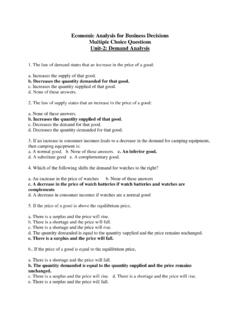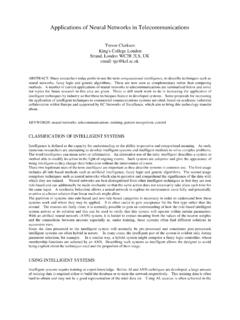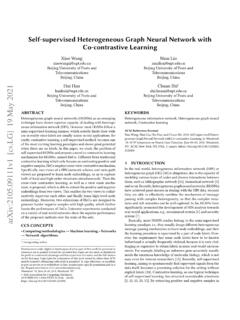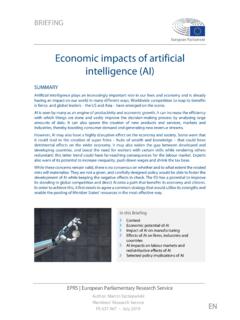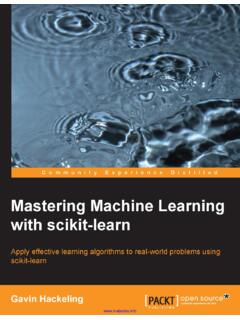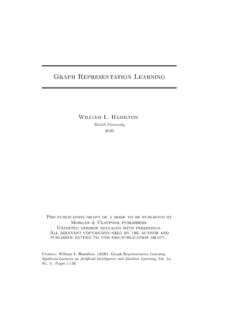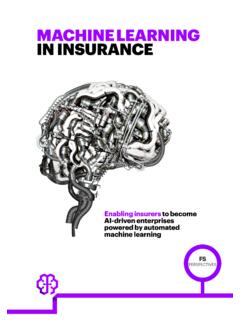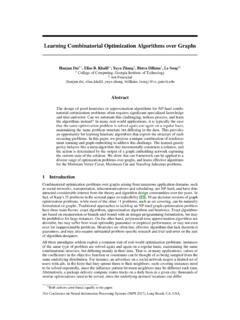Transcription of Unit 1 : Management Information System A) DSS B) MIS C ...
1 Unit 1 : Management Information System Q. 1. Information systems that monitor the elementary activities and transactions of the organizations are : A) Management -level System B) Operational-level, System C) Knowledge-level System D) Strategic level System Ans: A Q. 2. Projections and responses to queries are Information output characteristics associated with: A) DSS B) MIS C) ESS D) TPS Ans: C Q. 3. Summary transaction data, high-volume data, and simple models are Information Inputs characteristic of: A) DSS B) MIS C) ESS D) TPS Ans: B Which of the following individuals typically have less formal, advanced educational degrees and tend to process rather than create Information ? A) Knowledge workers B) Executives C) System analysts D) Data workers Ans: D Q. 5. Management Information systems usually: A) Serve managers interested in weekly, monthly, and yearly results, not day-to-day activities.
2 B) Help managers make decisions that are unique, rapidly changing, and not easily specified in advance. C) Provide managers with a generalised computing and telecommunications capacity that can be applied to a changing array of problems. D) Perform and record the daily routine transactions necessary to the conduct of business. Ans: A Q. 6. Identifying customers and markets using data on demographics, markets, consumer behaviour, and trends is an example of : A) Operational-level sales and marketing Information System . B) Knowledge-level sales and marketing Information System . C) Management -Level sales and marketing Information System . D) Strategic-level sales and marketing Information System Ans: B Deciding where to locate new production facilities is an example of a manufacturing and production Information System operating at the: a) Operational level b) Management level c) Knowledge level d) Strategic level Ans: D Q.
3 8. Preparing short-term budgets is an example of a finance and accounting Information System operating at the: a) Operational level b) Management level c) Knowledge level d) Strategic level Ans: D Q. 9. Tracking employee training, skills, and performance appraisal is an example of a human resource Information System operating at the: A) Operational level B) Management level C) Knowledge level D) Strategic level Ans: A Q. 10. Assembling a product, identifying customers and hiring employees are : A) Transactions B) Phases C) Business Processes D) Business Functions Ans: C Materials into intermediate and finished products, and distributing the finished products to customers? A) Production Chain B) Primary Chain C) Supply Chain D) Distribution chain Ans: C Q. 12. Information systems can facilitate supply chain Management by: A) Tracking the status of orders.
4 B) Rapidly communicating orders, C) Providing product specifications. D) none all of the above. Ans: D Q. 13. Enterprise systems support: A) Manufacturing processes. B) Financial and accounting processes. C) Human resource processes. D) All of the above. Ans: D Q. 14. A computer security protocol for logging in would be an example of the component of an Information System : A) software B) hardware C) Data D) Procedure Ans: D Q. 15. Customer numbers and their names would be an example of the _____ component of an order Management Information System . A) software B) hardware C) data D) procedure Ans: C Q. 16. The quality of your _____ is a large part of the quality of your Information System . A) computer B) thinking C) time D) challanges Ans: B Q. 17. Which of the following is not a characteristic of good Information ? A) Interchangeability B) relevance C) cost effectiveness D) timeliness Ans: A Q.
5 18. If you are a _____ recipient of sensitive Information such as might be overheard or contained in a misdirected email, this would not be legal, but-might be unethical to use it . A) active B) Passive C) proper D) business Ans: B A human order taker can be bypassed when using .. A) Office automation System B) Management Information System C) Transaction processing System D) Decision support System Ans: C Q. 20. Data mining cannot be done if _____ A) operational data has not been archived B) earlier Management decisions are not available C) the organisation is large D) all processing had been only batch processing Ans: A Q. 21. On-line transaction processing is used when _____ I) it is required to answer random queries ii) it is required to ensure correct processing iii) all files are available on-line Iv) all files are stored using hard disk. A) i, ii B) i, iii C) ii, iii, iv D) i, jj ,iii Ans: B Q.
6 22. Which is not a domain of-Artificial Intelligence? A) Intelligent Agents. B) Expert System . C) None of the above. D) A & B Ans: D Q. 23. Which computer based model is developed after human brain? A) Fuzzy Logic 8) Neural Network C) Virtual-Reality D) All of the above Ans: B Q. 24. Knowledge based System supports, _____ A) Knowledge of creation. B) Knowledge of support. C) Knowledge of Dissemination. D) All of the above. Ans: D Q: 25. Which of the System uses Multidimensional data analysis? A) DSS B) MIS C) ESS D) All of the above Ans: A Q. 26. Cybernetic System is the one which is _____ A) Self Monitoring. B) Self controlling. C) Self regulating. D) All Of the above. Ans: D Q. 27. Which of the following are the inputs of Marketing Information System ? i) Marketing research data II) Marketing intelligence data ii) External environment data iv) strategic plan A) Only I, ii, and iii.
7 B) Only ii, iii and iv. C) Only i, iii and iv. D) All I, ii, iii and iv. Ans: D Q. 28. _____ is the process of defining the current problem, determining why a new System is needed, identifying the objectives of the proposed System : A) Feasibility analysis B) System Analysis C) System definition D) System requirements , Ans: C Q. 29. The accounting System is _____ whereas the demand forecasting System is _____. A) deterministic, probabilistic B) probabilistic, deterministic C) open, close D) close, open Ans: A Q. 30. _____ Systems keep a track on the daily regular business transactions of the organisation. A) Management -level B) Strategic-level C) Executive Information D) Operational-level Ans: D Q. 31. In which of the following functions of MIS reports are generated based on the enterprise's need'? A) Planning B) Prediction, C) Data Processing D) Data storage Ans: A Q.
8 32. EIS provide highly unstructured Information to the level Management for long term decision making. A) Operational B) Bottom C) Middle D) Top Ans: D Q. 33. Which of the following Information category is used by middle Management ? A) Organisational B) Functional managerial knowledge C) Decision support D) Operational Ans: C Q. 34. _____ e-commerce applications use EDI over the secure Virtual private network. A) C2C : (Customer to CusJomer) B) C2B (Customer to Business Organisation) C) B2C (Business Organisation to Customer) D) B2B (Business Organisation to Business) Ans: D Q. 35. _____ focuses on researching how the human brain does work and, how human beings imagine. A) Cognitive science B) Robotics C) Natural interfaces D) Artificial intelligence Ans: A _____ makes use of groupware technology on Internet platform for faster response Processing. A) E-Communication B) E-business C) E-commerce D) E-collaboration Ans: C Q.
9 37. The-popular term for the software component that supports the collaborative efforts of a team is- A) videoconferencing software B) work flow automation software C) groupware D) none of above Ans: C Q. 38. EDI stands for: A) Electronic data interchanqe B) Electrical data interchange C) work flow automation software D) Enhanced data interchange Ans: A Q. 39. The direct, computer-to-computer exchange of standardized, common business transaction documents between business partners, suppliers, and customers is _____ A) EDI B) ES C) EIS D) ERP Ans: A Q. 40. MIS stands for _____ A) Management internet System . B) Marketing Internet System . C) Marketing and implementation software. D) Management Information System . Ans: D Q. 41. The Management Information System receives input from the: A) EIS. B) ES. C) DSS. D) TPS Ans: D Q.
10 42. The _____ provides a manager with the Information needed to make decisions regarding, the firm's operational activities. A) ElS B) ES C) MIS D) EDl Ans: C Q. 43. A combination of a MIS and DSS called _____ which helps top managers make decisions. A) GIS B) EIS C) EPI D) CAM Ans: B Q. 44: The first phase of IT planning is called _____ planning A) tactical B) project C) organisational D) strategic Ans : D Q. 45. Which of these items is a major component of today's IT infrastructure? A) data Management technology B) networking C) technology services D) all of me above Ana: D Q. 46. What software organizes, manages, and processes business data concerned with inventory, customers, and vendors? A) customer- oriented software B) data Management software C) storage area network network D) grid computing software Ans: B Q. 47. What type of computer is specially designed and/or used for tasks that require extremely rapid and complex calculations?







